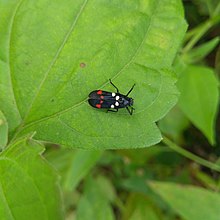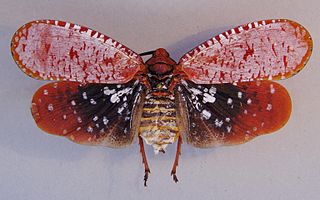
The subfamily Aphaeninae is a group of hemipteran insects, especially abundant and diverse in the tropics, in the family Fulgoridae, or "lanternflies".

Cercopidae are the largest family of Cercopoidea, a xylem-feeding insect group, commonly called froghoppers. They belong to the hemipteran suborder Auchenorrhyncha. A 2023 phylogenetic study of the family suggested the elevation of subfamily Ischnorhininae to full family status as Ischnorhinidae, leaving a monophyletic Cercopinae.
Platylomia is a genus of cicadas from Southeast Asia.

Flatidae are a family of fulgoroid planthoppers. They are cosmopolitan in distribution and are distinguished from others in the superfamily by a combination of characters. Like all other planthoppers, they suck phloem sap of plants. Some species are known to communicate with vibrations through the plant stems. Communication may be with mates, or with ants that tend the nymphs, protecting them and gathering honeydew secretions. Adults of some species have brightly coloured forewings which are tougher and known as tegmina unlike the membranous hindwings which are used for flight. Although a few can be identified by their coloration, most species requires dissection and examination under a microscope with access to literature on already described species.
Antestia is a genus of African and Asian bugs in the subfamily Pentatominae, erected by Carl Stål, 1865.
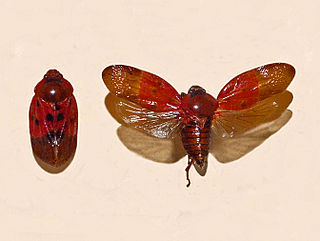
Leptataspis is a genus of Asian froghoppers belonging to the family Cercopidae and tribe Suracartini.

Penthicodes is a genus of planthoppers belonging to the family Fulgoridae, subfamily Aphaeninae: found in South-East Asia. The genus name was formerly treated as feminine, but in 2022 it was revised to masculine in accordance with ICZN Article 30.1.4.4, changing the spelling of several species' names.

Gergithus is a genus of tropical Asian planthoppers in the family Issidae, erected by Carl Stål in 1870. Like all planthoppers, adults feed on plant sap and are capable of escaping by leaping. The genus like other members in the tribe appears somewhat rounded and beetle-like, in some cases, with a mimetic resemblance to ladybird beetles. Species are mostly distributed in the Indomalayan Realm.

Pentatomini is a tribe of shield bugs in the subfamily of Pentatominae.

Calyptoproctus is a genus of planthoppers in the family Fulgoridae; records are from Central and South America.

The subfamily Poiocerinae include Hemipteran insects in the family Fulgoridae, found especially in the tropics.
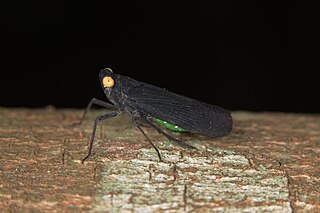
Desudaba is a genus of bugs in the family Fulgoridae, tribe Poiocerini. Records are from Australia and New Guinea.
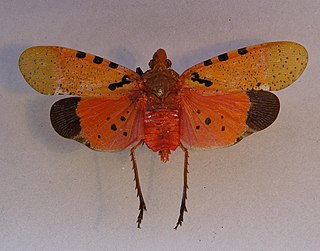
Belbina is a genus of planthoppers in the subfamily Enchophorinae (Fulgoridae): erected by Carl Stål in 1863; There are some 12 species presently known, occurring in Madagascar.

Kanaima is a genus of froghoppers endemic to Brazil & Argentina belonging to the family Cercopidae.
Poeciloterpa is a genus of froghoppers in the family Cercopidae. Endemic to the Philippines, there are about 13 described species in Poeciloterpa.

Euricania is a genus of true bugs belonging to the family Ricaniidae.

Cosmoscarta is a genus of froghoppers found in the Indo-Malayan region. Many of the species are boldly marked in black and red or yellow. A few species are of economic importance as they can cause injury to plants under cultivation.
Hypaepa is a genus of planthoppers in the family Fulgoridae, subfamily Poiocerinae. Species are distributed in Central America.

Scaralis is a genus of planthoppers in the family Fulgoridae occurring in Central America and South America. The genus contains 13 species, placed into two subgenera.
Enchophora is a genus of fulgorid planthoppers in the family Fulgoridae. There are more than 25 described species in Enchophora, found in Mexico, Central America, and South America.
